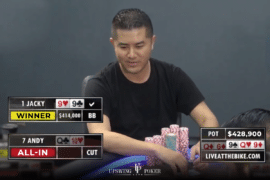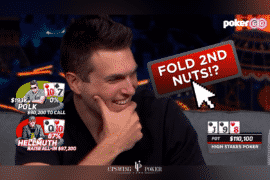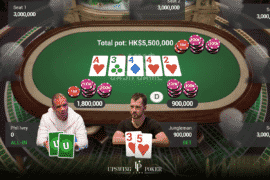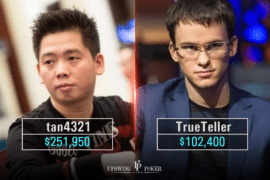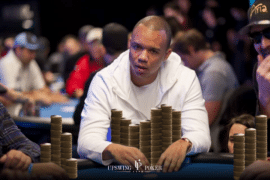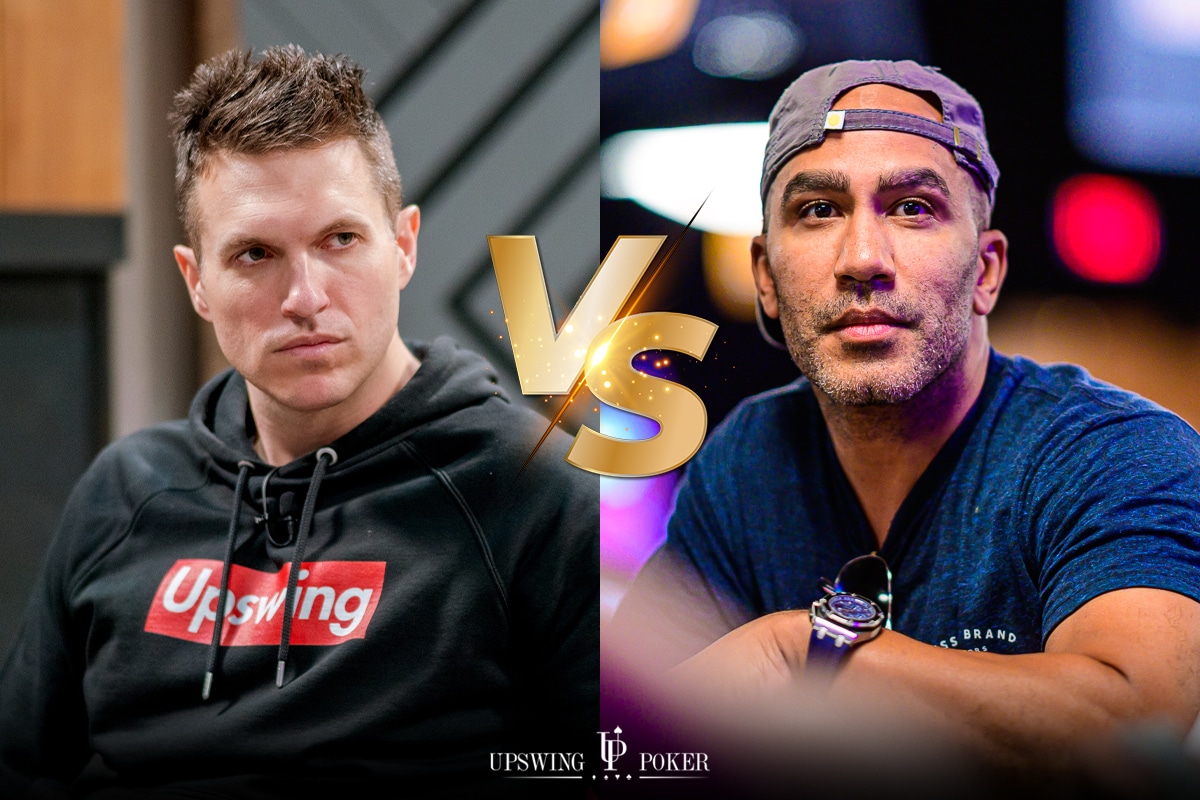
Retired Poker Pro Hits Full House vs Billionaire ($322,400 Pot)
I can’t wait to share with you one of the biggest pots that Doug Polk has ever played on Lodge Card Club’s stream.
The blinds are $200/$400/$800 with a $400 big blind ante. The effective stack between Doug and Bill Perkins is $157,300.
Without any further ado, let’s jump right in!
OUT NOW!
The Lucid GTO Cash Game Trainer
Improve your cash game skills fast (guaranteed) with this training tool!
Preflop
Doug raises to $2,000 with from the Hijack. Bulldog calls with from the Small Blind. Bill calls from the straddle with .
Simple Preflop Analysis
Doug makes a good preflop raise with . He should be raising all suited Aces from the Hijack.
Bulldog’s decision to call with is a little bit too loose. However, this is a loose and splashy game so he can likely get away with playing a few too many hands from the Small Blind.
Bill makes a solid call with in the Straddle. He has great pot odds and is closing the action.
It’s worth noting that the nit game is in play during this hand and Bill still has his nit button, which means he has a little extra incentive to try to win this pot.
Advanced Preflop Analysis
Doug has a clear open-raising hand with A6-suited. His raise size of 2.5x the straddle is also appropriate.
With the ante and straddle in play, Doug should be open-raising with around the top 25% of hands. This is slightly wider than a non-ante, non-straddle open-raising range. His range should look something like this:

Faced with Doug’s raise, Bulldog has two options for his overall approach in this spot. He can play a 3-bet only strategy or a mixed strategy (one with 3-bets and calls).
Regardless, though, King-Jack offsuit is not strong enough to play in this situation. Given the strength of Doug’s range coupled with the fact that there are 2 players left to act after him, he should be looking to continue with a pretty tight range.

That said, Bulldog is a smart and experienced live player who knows that sometimes you have to give action to get action (and to continue getting invited to big games). It’s certainly valid to loosen up a bit given that live-specific dynamic.
Bill makes the correct call with his Ace-Eight offsuit. He should be continuing with a wide range here given the following factors:
- Great pot odds
- In position against one of the opponents
- No rake will be taken out of the pot (players at Lodge Card Club pay an hourly seat fee instead)
Bill’s range would look something like this (includes 3-bets and calls):

All-in-all, preflop was played pretty well by all players.
Flop
The flop comes . The pot is $6,800.
Bulldog checks with his . Bill checks with his . Doug bets $3,400 with his . Bulldog calls. Bill calls.
Simple Flop Analysis
An action flop gives Doug two pair, Bill top pair, and Bulldog a gutshot straight draw.
Bulldog and Bill both make the correct decision to check. They should never be leading into the preflop aggressor (Doug) on this high-card heavy flop.
With his two pair, Doug makes the correct decision to bet. He has a strong hand that wants to build the pot right away with a decent-sized bet. His size (half pot) is reasonable.
Faced with this bet, Bulldog and Bill make the correct calls. Both hands that are strong enough to call and see a turn against this half-pot bet.
Advanced Flop Analysis
This flop heavily favors Doug in terms of nut advantage and overall equity advantage. The nut advantage comes from the fact that he is the only player that can have Pocket Aces, Pocket Queens, and Ace-Queen (since Bulldog and Bill would have 3-bet with those hands preflop).
When you have the nut advantage, you should tend to bet bigger.
Doug makes the correct decision to bet with his two pair. He can approach this spot from a few different perspectives. He can employ a smaller bet strategy here with most of his range, or he can use a more polarized, bigger bet strategy.
Doug chooses the big bet strategy (half pot is a relatively big flop bet in a multiway pot), which plays quite cleanly. What I mean by that is that when he uses this size, he should only be betting strong and better hands for value. He then should balance those out with some , , , and some backdoor draw hands as semi-bluffs.
I think this bigger bet strategy performs best, especially given that they are playing almost 200bb deep. With so much money behind, Doug has a greater incentive to build the pot fast in order to get all-in by the end of the hand.
Bulldog’s and Bill’s calls are perfectly justified, even against the relatively big bet. They both have enough equity and implied odds to profit by calling.
Turn
The turn comes the , making the board . The pot is $17,000.
Bulldog checks. Bill checks. Doug bets $20,500 with his two pair. Bulldog folds his straight draw. Bill calls with his top pair.
Simple Turn Analysis
The on the turn changes nothing for any of the player’s hands.
Bulldog and Bill both correctly check to Doug. They have no incentive to lead here.
With his two pair, Doug makes the correct decision to keep betting for value. By overbetting the pot, he puts the maximum pressure on his opponents and sets himself up to win as much money as possible.
Bulldog’s straight draw is far too weak to continue. He makes a good (albeit easy) fold.
With top pair weak kicker, calling and folding are both okay options for Bill. Doug is an aggressive player, so it’s hard to fault him for calling. But unless the river is an 8, Bill may find himself in an even tougher situation on the river.
Advanced Turn Analysis
A turn that further divides Bulldog/Bill’s ranges from Doug’s range. The two out of position players’ ranges are full of bluff-catchers with few super strong hands. That puts them at Doug’s mercy because he has many super strong hands like sets and two pairs. For these reasons, they must check to the aggressor again.
Doug should continue exerting pressure with his powerful range. An overbet here is the perfect size (anywhere from 1.2x pot to 1.75x pot) because he has absolute reign on the upper-hand strength classes (top two pairs and sets). He should be mixing these hands with an appropriate amount of bluffs (a bit more than 1:1 bluff-to-value ratio, in favor of bluffs).
After Bulldog makes the clear fold, Bill’s hand is on the fence between calling and folding. He probably has a mixed-frequency call at equilibrium (meaning both options are fine). It’s hard to say if calling here is profitable or not. I cannot fault him for doing so against a capable player like Doug.
River
The river comes the , making the final board . The pot is $58,000.
Bill checks. Doug shoves $132,200.
Simple River Analysis
A brutal river for Bill gives him trips vs Doug’s full house.
Bill is once again correct to check it over to Doug. His hand may have improved, but he’s still behind all of the super strong hands (AQ, QQ, 66) in Doug’s range.
Doug makes a savvy decision to overbet all-in. This is how he should play all of the best hands in his range, mixed in with some bluffs.
Bill is in a nasty spot here and I think both calling and folding are justifiable. It depends on how often he thinks Doug is bluffing.
Bill has to call $132,200 to win a $190,200 pot. Based on his pot odds, he has to be good here 41% of the time for his call to break even. So, if he thinks Doug is bluffing over 41% of the time, he should call.
Of course, estimating how often your opponent is bluffing in-game is incredibly difficult. You can do some crude math in your head, but it’s tough to be precise! I’ll do a deeper dive into the math in the Advanced River Analysis below.
Would you make the call as Bill in this situation? Let me know in the comments below.
Advanced River Analysis
All draws miss, which is important to note because it means Doug’s potential bluffing hands (straight draws like or ) are still nothing-burgers.
Doug plays it perfectly when checked to, putting all the money in. That is the way top-value hands should be played.
In theory, Doug should accompany his value hands (full houses and Ace-King) with an appropriate amount of bluffs. In this case, his range needs to be comprised of ~70% value hands and 30% bluffs. This might shock you, but the math proves that this is an unexploitable strategy.
The math: While it is true that according to straightforward math, Doug needs 41% bluffs (due to Bill needing 41% equity to break even with his bluff-catchers), this is a special case. It’s a special case because Bill’s bluff-catchers have extreme blocker effects on Doug’s value range, blocking around 40% of his value range.
If a poker hell exists, Bill is living in it. He is on the river, facing an enormous overbet, with a pure bluff-catcher that looks like a hand that is too good to fold.
He is holding a perfect bluff-catcher. He is blocking a large amount of Doug’s value hands while unblocking a large amount of his potential bluffs (King-Jack, King-Ten, Jack-Ten, etc). It is a prime candidate for bluff-catching.
In the end, this all comes down to how he perceives Doug to be balancing his range here:
- If he thinks Doug is balanced, then he may call or fold without any consequence
- If he thinks Doug is under-bluffing, he should fold since he isn’t winning enough of the time
- If Doug is over-bluffing, then he should call and exploit this weakness
This ties in with a point I made in the turn section.
Over the years, Doug has cultivated an image of an aggressive player. Everyone who has watched him play knows he is capable of (over)-bluffing in extremely large pots. This not only makes him tough to play against, but it allows him to get paid off more often in situations like this one.
Results
Bill tank-calls with his trips. Doug shows his full house and wins the $322,400 pot.
What do you think of Bill’s call on the river?
I’m curious to hear what everyone thinks in the comments below.
If there is one takeaway here, it’s that aggression pays off when used intelligently, and image matters. Doug has been intelligently aggressive and has cultivated his image. That paid off in this hand.
I don’t think Bill should be upset at himself with this call. It was an extremely hard situation to deal with.
That’s all for this article! I hope you enjoyed it and that you learned from it! As usual, if you have any questions or feedback feel free to leave a comment in the section down below.
If you want some more high stakes hand analysis, check out Millionaire Poker Pro Gets Tricky With Pocket Aces in $116,668 Pot (Analysis).
Till’ next time, good luck, grinders!
Note: The Lucid GTO Cash Game Trainer is amazing for coming up with strategies you can take to the table.
Practice against “perfect” opponents and get instant feedback on your play. Or you can browse entire strategies for any common spot.



